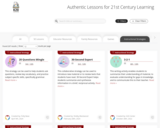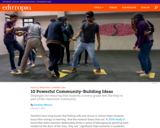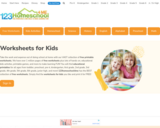
Suggestions for what to put in a Maker Space.
- Subject:
- Business
- Education
- English Language Arts
- Math
- Science
- Material Type:
- Primary Source
- Author:
- Makerspaces.com
- Date Added:
- 03/14/2019

Sun West endorsed resources.
Sun West endorsed resources.

Suggestions for what to put in a Maker Space.

100 Questions that Promote Mathematical Discourse
Includes questions that:
*help students work together to make sense of math
*teach students to rely on themselves to determine if something is mathematically correct
*learn to reason mathematically
*evaluate their own processes
*help with problem comprehension
*help students learn to conjecture, invent and solve problems
*learn to connect mathematics, its ideas and its application
*help persevere
*help students focus on focus on the mathematics from activities

Wow! 100+ teaching and learning strategies! Flip a card to read about the strategy. You can download PDFs and PowerPoints.
You can sort activities by group size, and the required time needed to complete the tasks.
Unfortunately, this site only works on Chrome on the desktop.

Help your teens and tweens find fun things to do this summer with 100 summer activities for teens.
This list is geared toward teens and tweens, which means some ideas will be more interesting to those at the younger end of the scale (ex: making marshmallow launchers) while others will be more appropriate for older kids (ex: going on a college campus tour). But there should be plenty of ideas for everyone that will keep your youth engaged and learning over the summer!
Note: click on linked text to get more info/instructions about that specific idea!

As well as being fun, the activities on this printable list all promote playful investigation and/or learning. Perfect for keeping kids learning all summer long…without them even realizing it! Plus, it’s the perfect partner to another printable 101 activity list – 101 Things to Do Outdoors (find the link on this site).

These free online translators are perfect for fast word or sentence swapping to other languages. Some offer other features as well. They include:
1. Google Translate
2. Bing Translator
3. Translatedict
4. Translate.com
5. DeepL Translator
6. PROMT Online Translator
7. Collins Dictionary Translator
8. ImTranslator
9. SpanishDict
10. Reverso

"Boost your wellbeing during the crisis.
The Covid-19 pandemic brings big challenges for our mental health, whether you're isolating at home or trying to live with the new restrictions. This program can help you cope and find a little more happiness in these crazy times.
Learn how to be happier.
10 Days of Happiness is a free online coaching program which guides you through daily actions for happier living."

Jamboard is a free Google tool that creates whiteboards that are a lot like slides. You don't need an interactive whiteboard to use it. You can use the app for free on any device! It works with Google Drive and allows you to present your whiteboard to people viewing remotely. Which makes it a great online whiteboard option for distance learning.
Check out the "Getting started with Jamboard video" and the 10 Jamboard templates that you can use for remote learning.
Click on the the "The Google Teacher Center" link to discover has some great resources for educators looking to get started using Jamboard in their classrooms. Resources include:
- a video library or tutorials
- tips and trick from teachers
- PDF guides
- lesson plans and more

A fabulous collection of Harry Potter activities with a focus on Science!
These would make a great series of STEM challenges or a Harry Potter theme day (or days) in your classroom.

As technology infiltrates every aspect of our lives, it is no wonder that solving crimes has become almost futuristic in its advances. From retinal scanning to trace evidence chemistry, actual forensic technologies are so advanced at helping to solve crimes that they seem like something from a science fiction thriller.
With all this forensic technology, its no wonder that this field is one of the fastest growing in the U.S. Shows like CSI and NCIS have made most of the forensic science techniques used today common knowledge. You might think that virtually the whole gamut of forensic technology is old hat to today’s savvy viewer. In fact, there are a number of incredibly cool forensic technologies that you probably never knew existed.
Covers the following 10 technologies:
1. Laser Ablation Inductively Coupled Plasma Mass Spectrometry (LA-ICP-MS)
2. Alternative Light Photography
3. High-Speed Ballistics Photography
4. Video Spectral Comparator 2000
5. Digital Surveillance For Xbox (XFT Device)
6. 3D Forensic Facial Reconstruction
7. DNA Sequencer
8. Forensic Carbon-14 Dating
9. Magnetic Fingerprinting and Automated Fingerprint Identification (AFIS)
10. Link Analysis Software for Forensic Accountants

Teachers have long known that feeling safe and secure in school helps students focus their energy on learning. And the research bears that out: A 2018 study found that when teachers deliberately foster a sense of belonging by greeting each student at the door of the class, they see “significant improvements in academic engaged time and reductions in disruptive behavior.”
This post outlines ideas from teachers for ensuring that every student in the classroom feels like they belong.
Some of the activities included take less than five minutes. They’re divided up among the grades, but many can apply across all of the years from kindergarten to 12th grade.

1. Citizen Science
2. Stop Motion Animation
3. Astronomy & Stargazing
4. Virtual Field Trips
5. Coding & Robotics
6. Weather Tracking
7. Plant a Garden
8. Music & Sound Experiments
9. Augmented Reality Science
10. Other Experiments & Simulations

Homeschool Worksheets have over 1 million pages of FREE worksheets for toddler, preschool, pre k, kindergarten, first grade, 2nd grade, 3rd grade, 4th grade, 5th grade, 6th grade, 7th grade, and 8th grade students in K12. The free educational printables cover alphabet letters, math, language arts, history, geography, and more.
All the free homeschool worksheets on this site can be accessed by subject or grade level. Just click on any of the category thumbnails see that category of free printables.

The 1-2-3 Process Form for RTI

In Rick Wormeli’s article Redos and Retakes Done Right, he states “allowing students to redo assignments and assessments is the best way to prepare them for adult life.”
According to Wormeli, many teachers feel that denying students opportunities to show their full potential after providing substantial results builds ‘moral fibre’. These teachers have the mindset that there should be rigid deadlines for assignments and that marks should be taken off for late submissions, and even give zeroes in some situations. Wormeli counters by claiming that “these practices have the opposite effect: They retard student achievement and maturation.”
In Kenaston School, specifically in math and the senior sciences, students have the opportunity to redo assessments in 2011-2012. Teachers have taken Wormeli’s guidelines into consideration, applying some of his recommendations. Kenaston teachers advise that by incorporating Wormeli’s ideas into practice, teachers can make redos fair for both the student and teacher.

The ability to gather and analyze different types of evidence is one of the most important competencies for anyone who conducts investigations. There are many types of evidence that help the investigator make decisions during a case, even if they aren’t direct proof of an event or claim.
The first rule is that evidence must be relevant to the investigation. If it is not directly related to the case it isn’t relevant evidence. That said, there are many types of evidence that, while not admissible in court, can be valuable to an investigator trying to reach a conclusion in a workplace investigation or other non-criminal investigation. And even some evidence that is not admissible on its own may be admissible in conjunction with other types of evidence.

These 16 everyday learning activities we do with our children at home during school closures certainly count as learning. Thank you to We Are Teachers for this excellent graphic.

Prompts for the whole year!

The Canadian War Museum have a list of “Online Exhibitions”, one of which is a website that can take you through the War of 1812 from four different perspectives, showing how Americans, Brits, Canadians and Indigenous peoples experienced the war.

The following document contains everything you need to get started with Learner Profiles. Suggested inventories and resoures are included by grade grouping. Section 1 - Getting Started...Read This First (really...read this first!);Secton 2 - Kindergarten to Grade 2 Resources;Section 3 - Grade 3 to 5 Resources;Section 4 - Grade 6 to 9 Resources;Section 5 - Grade 10 to 12 Resources;Section 6 - How to Build a Learner Profile;Section 7 - Now What?